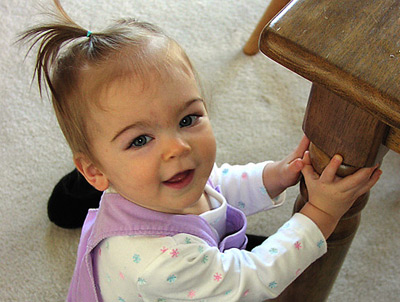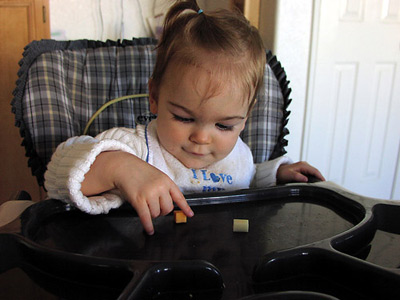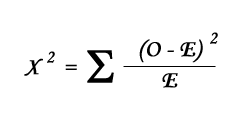Ger and I were arguing one day about what kind of cheese Sam likes better, Cheddar or Swiss. Yes, we argue about these kinds of things. Before we had a kid we debated politics, philosophy, and the ontological mysteries of the cosmos, but now it’s pretty much “How much did Sam poop today?” and “Which cheese do you think she likes better?”
I figured, though, that we need not rely on pure speculation for the answer to this last question. If my Ph.D. in Psychology is good for anything, it’s determining cheese preferences in little girls. So I concocted an experiment, ran it, and wrote up the results below. Yes, seriously.
The researcher was interested in cheese preferences among babies who are his daughter. The implications for such research include grocery shopping planning, general happiness of the population in question, and giving the researcher something stupid to write about on his blog.
A review of the baby literature yielded very little useful information. It has been found that babies prefer “Buh-buh” and “crapping themselves” but little substantive research has focused on dairy products in particular. Obviously, this highlights the tremendous value of the present research.
Given the dearth of research on the subject, the researcher was not comfortable specifying a specific hypothesis about cheese preference. Instead, he will simply test the null hypothesis:
The study employed a simple 2×1 within-subject, repeated measure design. The rest of this section describes the sample, stimulus materials, and procedure employed in the present research.
Sample
Uh, pretty much just Samantha. I really don’t care about anybody else’s kids, so she’s the entire population of interest.
 Figure 1: The population |
Stimulus Materials
In an effort to keep the research manageable, the researcher decided to limit his investigation to Cheddar and Swiss cheeses. Also, these are the only ones we ever really get coupons for. A block of each cheese was procured from the local grocery store and each was cut into many half-inch cubes for a total of 76 pieces.
 Figure 2: Stimulus Materials |
Each type of cheese was then placed in a special, scientifically prepared, plastic container. Okay, they’re not special containers. They were just these little Tupperware containers that we put all of Sam’s food in. But we do it scientifically.
 Figure 3: Materials Preparation |
Procedure
Each day the researcher or his assistant (hi, Geralyn!) would run 5-7 experimental trials. Each trial involved sitting the Subject in a high chair and placing two cheese cubes –one Cheddar and one Swiss– in front of her. It was then noted which type of cheese the Subject ate first and this information was coded on a specially prepared piece of paper. Using, uh, a pen. A scientific pen.
 Figure 4: An experimental trial in progress |
After the Subject made her choice, the remaining cheese cube was removed (often under protest by the Subject) and two more pieces were placed on the tray. The left/right order of the cubes was varied so that if the Subject had a preference for the cheese on the left or right that error variance would be evenly distributed across conditions.
Data collection was spread out over 12 days lest the Subject become really, really constipated.
Table 1 shows the distribution of cheese choices made by the Subject across all 76 experimental trials. The “Observed” row shows the number of each cheese cubes actually chosen while the “Expected” row shows the number of cubes one would expect her to choose if there were no preference.

|
To test the Null Hypothesis of no preference, the researcher took the categorical data in Table 1 and conducted a Chi-Square analysis. As you may remember from your remedial math class in junior high, this is the formula for Chi-Square test:

|
Where O is the Observed cheese choice for each type (Cheddar or Swiss) and E is the expected choice. Filling in the values from Table 1, we get an observed Chi-Square of 1.895:

|
Referencing a table of Chi-Square distributions, it is noted that with 1 degrees of freedom, an observed Chi-Square of 1.895 does not reach the critical value for alpha = .05 (or even .10). Thus, the null hypothesis is not rejected.
Well, just like my dissertation and my master’s thesis, I’ve once again failed to find significant results. Samantha appears to prefer neither Cheddar nor Swiss; she likes them both equally. During the course of the experiment she chose Swiss more often than Cheddar (44 Swiss cubes vs. 32 Cheddar cubes), but the difference was not large enough to rule out random chance as the cause as opposed to a taste preference.
Future research might investigate the question of whether the Subject more often prefers the cheese on the right- or left-hand side to the extent that this overwhelms any other preference.
So there. Can I get tenure now?
That was awesome. Thanks for a great read and, though homorous, actually logical execution of research.
I believe you’re suffering from a Type II error Jamie. I calculated the effect size (some old ass Indian guy comes to mind) using Cramer’s Phi and got a correlation of .22 which can be interpreted the same as a Pearson r. Not great, but not too bad either. I bet you’d give your right arm to get the same coefficient for the CSR and BST. God I love chi squares. I think all statistics should be confined to chi squares and contigency tables (anything more and executives get confused).
A correlation? Between what? At any rate, I wouldn’t stake my professional career on .22. This is CHEESE we’re talking about here, man. Not just some employment test that will determine the future career prospects of hundreds of people. You gotta be conservative.
Also, thanks Warthog! 🙂